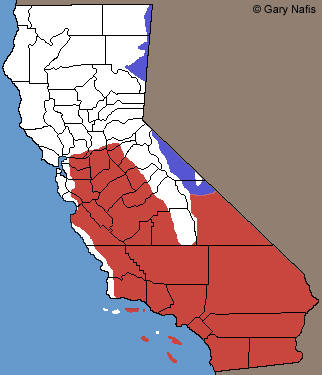|
 |
| Adult, Inyo County |
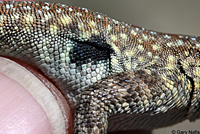 |
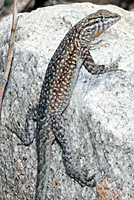 |
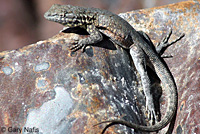 |
| The "side blotch" - a dark mark on the sides behind the front legs - gives this species its common name. |
Adult male, Inyo County |
Adult, Inyo County |
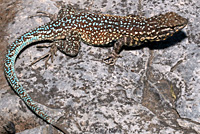 |
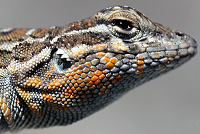 |
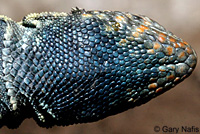 |
| |
Adult male, Inyo County |
|
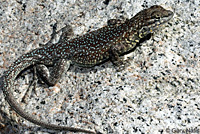 |
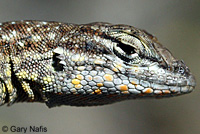 |
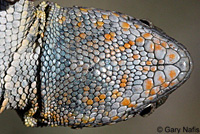 |
| |
Adult male, Inyo County |
|
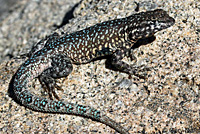 |
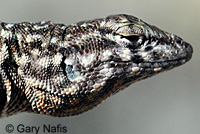 |
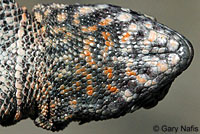 |
| |
Adult male, Inyo County |
|
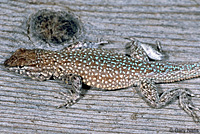 |
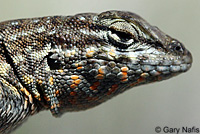 |
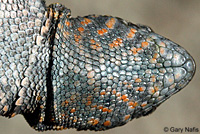 |
| Adult male, Inyo County |
Adult male, Inyo County |
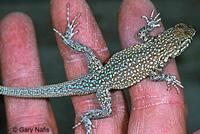 |
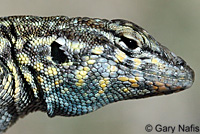 |
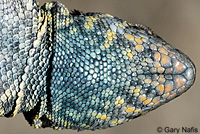 |
| Adult male, Inyo County |
Adult male, Inyo County |
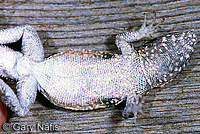 |
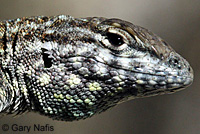 |
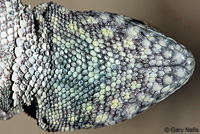 |
| Adult male, Inyo County |
Adult male, Inyo County |
| |
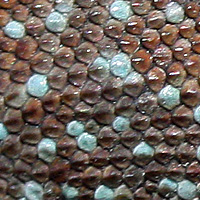 |
|
| |
The Side-blotched Lizards, genus Uta, have small keeled spineless scales on the back. |
|
| |
|
|
| Nevada Side-blotched Lizards From Outside California |
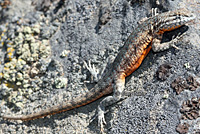 |
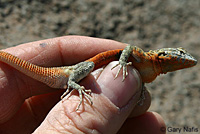 |
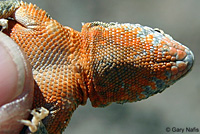 |
Breeding adult male,
Grant County, Washington |
Adult male with breeding season orange coloring (late May),
Grant County, Washington |
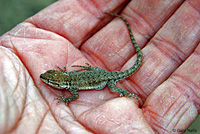 |
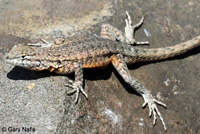 |
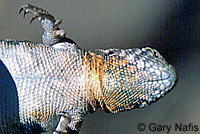 |
| Juvenile, Grant County, Washington |
Breeding adult male,
Grant County, Washington |
Adult, Grant County, Washington |
| |
 |
|
| |
This little hatchling, barely the size of a US quarter dollar coin, was found wandering around an office lobby in Benton County, Washington.
© Kim Burtnyk |
|
| |
|
|
| Habitat |
 |
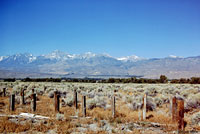 |
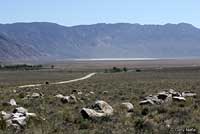 |
| Habitat, Modoc County sagebrush desert |
Habitat, Inyo County high desert |
Habitat, sagebrush desert, Inyo County |
| |
|
|
| Short Video |
| |
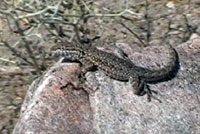 |
|
| |
Nevada Side-blotched Lizards from the sagebrush desert of northern
Inyo County. |
|
|
|
|
| Description |
| |
| Size |
1.5 - 2.5 inches long from snout to vent (3.8 - 6.3 cm). (Stebbins 2003)
|
| Appearance |
| A small brownish gray lizard with small smooth and spineless slightly keeled scales on the back, larger spineless keeled scales on the limbs and tail, a gular fold, and a long thin tail. |
| Color and Pattern |
Color is brown, gray, yellowish, or black, with dark blotches, spots, and sometimes stripes.
Often there is a double row of dark spots or wedges on the back, edged with white on the rear.
The underside is whitish to gray and mostly unmarked.
The throat is mottled with dark and light.
A dark blue-black mark on the sides of the chest behind the front limbs gives this lizard its name.
This mark is sometimes faint or absent.
This subspecies is characterized by consisting of mostly scattered light and dark spotting.
|
| Male / Female Differences |
Males are more colorful than females, having blue speckles on the upper surfaces, which are most visible during the light phase.
Northern lizards sometimes develop orange on the throat and belly.
Males also have a swollen tail base and enlarged post-anals, but no distinct blue coloring on the belly (which can be found on male lizards of many other species.)
The throat is marked with blue, orange, or yellow.
Females are blotched on top with brown and white, often with stripes, and have a less well-defined blotch on the sides.
They have no blue speckling, and no color on the throat. |
| Similar Subspecies |
| This subspecies is distinguished by a fairly uniform dorsal pattern of scattered dark and light spots, a more reduced pattern than U. s. elegans. |
| Three Male Color Morphs and Associated Behavior |
Some fascinating discoveries have been made recently that show cooperative behavior with this species. Males have blue, orange, and yellow color morphs.
Researchers are calling this a "Rock-Paper-Scissors"game of male breeding strategies, because each color has an advantage over one other color, but not over both other colors.
Orange-throated males - are dominant, aggressive and territorial and mate with many different females.
Yellow-throated males - do not defend territories. They mimic females and sneak past territorial orange-throated males to mate with their females.
Blue-throated males- guard their mates, chasing off the yellow males, but they are run off when confronted by orange males. Blue males also cooperate with neighboring blue males to protect their respective mates from the orange and yellow males, and their breeding is much more successful when they do so.
(Sinervo and Zamudio, 2001)
Watch a video about this behavior: KQED Deep Look
Read more about this: MVZ UCSC
|
| Life History and Behavior |
Activity |
Diurnal.
Active much of the year whenever the temperature is warm.
Inactive during winter and during cold weather.
The most abundant and commonly-seen lizard in the deserts and semi-arid areas.
Usually the first lizard species out in the morning due to its small size which allows it to warm up quickly.
It is active mostly on the ground, but is also a good climber.
Often seen basking on rocks, hopping from boulder to boulder, or running quickly along the ground.
The tail is often broken off when a lizard is captured, but it will grow back with time.
|
| Longevity |
| This lizard is short-lived, living only about one year. |
| Territoriality |
| Males use a push-up display to display their territory. |
| Defense |
Often this lizard can be approached closely, since it relies on crypsis as a defense against predation, but when frightened it runs quickly into a burrow, under a surface object, or under vegetation.
The tail can break off easily, but it will grow back.
The detached tail wriggles on the ground which can distract a predator from the body of the lizard allowing it time to escape.
More information about tail loss and regeneration. |
| Diet and Feeding |
Primarily insectivorous - eats small invertebrates such as beetles, grasshoppers, ants, spiders, scorpions and ticks.
Plant matter is sometimes eaten either for its water or by accident. |
| Reproduction |
Mates mostly in the spring. 1 - 7 clutches of 1 - 8 eggs are laid from March to August. (Stebbins 2003)
Females can store sperm to fertilize eggs at a later time.
Juveniles hatch from June to September, and breed the following spring.
|
| Habitat |
Prefers open rocky areas with scattered vegetation, including the edges of sandy washes. Utilizes a wide variety of habitats, including hardpan, sandy, rocky, and loamy areas grown with sagebrush, scattered trees, grass, and shrubs.
|
| Geographical Range |
In California, this subspecies is found east of the Sierra Nevada Mountains and in the far northeastern corner of the state, corresponding the the Great Basin desert portions of the state.
Its range outside California continues into northwestern Nevada, southwestern Idaho, easter Oregon, and mid central Washington.
The species ranges through most of California south of the Bay Area, all of Nevada, eastern Oregon, southwestern Idaho, central Washington, most of Utah, the western edge of Colorado, much of New Mexico the west part of Texas, north-central Mexico, along the west coast of Sonora, all of Baja California and many of its islands.
|
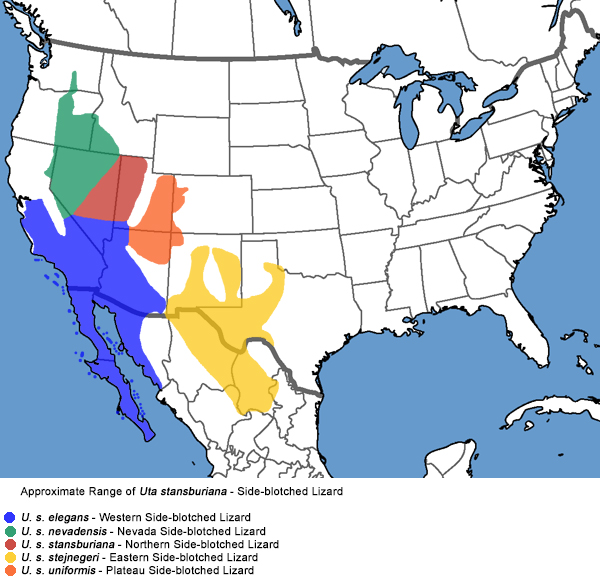 |
| Elevational Range |
From below sea level to around 9,000 ft. (2,700 m). (Stebbins 2003)
|
| Notes on Taxonomy |
The taxonomy of this widespread and variable species has been disputed. Some experts do not recognize any subspecies of Uta stansburiana pending further studies that will provide more clarification about this species (which may include several different species).
--------------------------------------------------------------------------------------------------------------------------------------------------------------------
Three subspecies of Uta stansburiana are sometimes shown occurring in California, including U. s. stansburiana -
Nevada Side-blotched Lizard, which is shown to range east of the Sierra Nevada Mountains in Inyo and Mono counties.
--------------------------------------------------------------------------------------------------------------------------------------------------------------------
"U. s. nevadensis Ruthven, 1913—Nevada Side-blotched Lizard
The standard English name of this subspecies has been changed because the previous one (“Northern”) was descriptively misleading given that the distribution of U. s. nevadensis extends farther to the north."
(Nicholson, K. E. (ed.). 2025 SSAR Scientific and Standard English Names List)
--------------------------------------------------------------------------------------------------------------------------------------------------------------------
Alternate and Previous Names (Synonyms)
Uta stansburiana - Common Side-blotched Lizard (Stebbins 2003, 2012)
Uta stansburiana - Side-blotched Lizard (Stebbins 1985)
Uta stansburiana stansburiana - Northern Ground Uta (Smith 1946, Stebbins 1966)
Uta stansburiana stansburiana - Northern Brown-shouldered Lizard (Grinnell and Camp 1917)
|
| Conservation Issues (Conservation Status) |
| None |
|
|
Taxonomy |
| Family |
Phrynosomatidae |
Zebra-tailed, Earless, Fringe-toed, Spiny, Tree, Side-blotched, and Horned Lizards |
Fitzinger, 1843 |
| Genus |
Uta |
Side-blotched Lizards |
Baird and Girard, 1852 |
| Species |
stansburiana |
Common side-blotched lizard |
Baird and Girard, 1852 |
Subspecies
|
nevadensis |
Nevada side-blotched Lizard |
Ruthven, 1913 |
|
Original Description |
Uta stansburiana - Baird and Girard, 1852 - Proc. Acad. Nat. Sci. Philadelphia, Vol. 6, p. 69
Uta stansburiana nevadensis - Ruthven, 1915 - Proc. Biol. Soc. Washington, Vol. 26, p. 27, fig. 1
from Original Description Citations for the Reptiles and Amphibians of North America © Ellin Beltz
|
|
Meaning of the Scientific Name |
Uta - state of Utah - refers to the region where it was first discovered.
stansburiana - honors Stansbury, Howard S.
nevadensis - belonging to the state of Nevada - probably refers to the type locality.
from Scientific and Common Names of the Reptiles and Amphibians of North America - Explained © Ellin Beltz
|
|
Related or Similar California Lizards |
U. s. elegans - Western Side-blotched Lizard
|
|
More Information and References |
NatureServe Explorer
USGS
Male Uta cooperation and throat colors
Hansen, Robert W. and Shedd, Jackson D. California Amphibians and Reptiles. (Princeton Field Guides.) Princeton University Press, 2025.
Stebbins, Robert C., and McGinnis, Samuel M. Field Guide to Amphibians and Reptiles of California: Revised Edition (California Natural History Guides) University of California Press, 2012.
Stebbins, Robert C. California Amphibians and Reptiles. The University of California Press, 1972.
Flaxington, William C. Amphibians and Reptiles of California: Field Observations, Distribution, and Natural History. Fieldnotes Press, Anaheim, California, 2021.
Nicholson, K. E. (ed.). 2025. Scientific and Standard English Names of Amphibians and Reptiles of North America North of Mexico, with Comments Regarding Confidence in Our Understanding. Ninth Edition. Society for the Study of Amphibians and Reptiles. [SSAR] 87pp.
Samuel M. McGinnis and Robert C. Stebbins. Peterson Field Guide to Western Reptiles & Amphibians. 4th Edition. Houghton Mifflin Harcourt Publishing Company, 2018.
Stebbins, Robert C. A Field Guide to Western Reptiles and Amphibians. 3rd Edition. Houghton Mifflin Company, 2003.
Behler, John L., and F. Wayne King. The Audubon Society Field Guide to North American Reptiles and Amphibians. Alfred A. Knopf, 1992.
Robert Powell, Roger Conant, and Joseph T. Collins. Peterson Field Guide to Reptiles and Amphibians of Eastern and Central North America. Fourth Edition. Houghton Mifflin Harcourt, 2016.
Powell, Robert., Joseph T. Collins, and Errol D. Hooper Jr. A Key to Amphibians and Reptiles of the Continental United States and Canada. The University Press of Kansas, 1998.
Bartlett, R. D. & Patricia P. Bartlett. Guide and Reference to the Turtles and Lizards of Western North America (North of Mexico) and Hawaii. University Press of Florida, 2009.
Jones, Lawrence, Rob Lovich, editors. Lizards of the American Southwest: A Photographic Field Guide. Rio Nuevo Publishers, 2009.
Smith, Hobart M. Handbook of Lizards, Lizards of the United States and of Canada. Cornell University Press, 1946.
Taylor, Emily. California Lizards and How to Find Them. Heyday, Berkeley, California. 2025.
Joseph Grinnell and Charles Lewis Camp. A Distributional List of the Amphibians and Reptiles of California. University of California Publications in Zoology Vol. 17, No. 10, pp. 127-208. July 11, 1917.
|
|
|
The following conservation status listings for this animal are taken from the July 2025 State of California Special Animals List and the July 2025 Federally Listed Endangered and Threatened Animals of California list (unless indicated otherwise below.) Both lists are produced by multiple agencies every year, and sometimes more than once per year, so the conservation status listing information found below might not be from the most recent lists, but they don't change a great deal from year to year.. To make sure you are seeing the most recent listings, go to this California Department of Fish and Wildlife web page where you can search for and download both lists:
https://www.wildlife.ca.gov/Data/CNDDB/Plants-and-Animals.
A detailed explanation of the meaning of the status listing symbols can be found at the beginning of the two lists. For quick reference, I have included them on my Special Status Information page.
If no status is listed here, the animal is not included on either list. This most likely indicates that there are no serious conservation concerns for the animal. To find out more about an animal's status you can also go to the NatureServe and IUCN websites to check their rankings.
Check the current California Department of Fish and Wildlife sport fishing regulations to find out if this animal can be legally pursued and handled or collected with possession of a current fishing license. You can also look at the summary of the sport fishing regulations as they apply only to reptiles and amphibians that has been made for this website.
There are no significant conservation concerns for this animal in California.
|
| Organization |
Status Listing |
Notes |
| NatureServe Global Ranking |
|
|
| NatureServe State Ranking |
|
|
| U.S. Endangered Species Act (ESA) |
None |
|
| California Endangered Species Act (CESA) |
None |
|
| California Department of Fish and Wildlife |
None |
|
| Bureau of Land Management |
None |
|
| USDA Forest Service |
None |
|
| IUCN |
|
|
|
|
